The evolution of stars(恒星的演化)
- 格式:docx
- 大小:17.27 KB
- 文档页数:5

自然科学公共选修课程——科学基础天文学导论 (278)物理学思想史与自然哲学 (280)等离子体科学和应用 (282)太空之旅 (284)创新与发明 (286)中国古代冶铸技术 (287)电影中的科学理念探讨 (289)思维能力与工程制图 (290)激光与现代生活概论 (293)营养化学 (295)美容化学 (297)《天文学导论》课程教学大纲一、课程名称天文学导论Introduction to Astronomy二、课程编码1405961三、学时与学分32/2四、先修课程无五、课程教学目标本课程为非天文专业的理工科或文科学生普及天文学知识而开设。
内容包括宇宙概貌,太阳系,九大行星,地球,月球,日蚀,月蚀的形成原因,恒星的形成,演化与死亡的规律。
致密星如中子星和黑洞的特征,星系的概念以及宇宙大爆炸学说等天文学基础知识。
讲授采用双语教学,配合大量多媒体精采图片以及天文学科普电影资料,以形象描述为主,基本上不用数学公式。
这样既可以去除学生的畏难情绪,又可以激发学生探索宇宙奥秘的兴趣,使他们感到确有收获。
六、适用学科专业全校各专业七、基本教学内容与学时安排Chapter 1 The universe at different scales (宇宙的不同尺度) (1学时)Chapter 2 The earth and the sky (地球和天空) (2学时)Chapter 3 Lunar phases, tides and eclipses (月相, 潮汐和蚀) (2学时)Chapter 4 The origin of modern astronomy (现代天文学的起源) (2学时)Chapter 5 Theory of motion and gravitation (运动理论和引力) (2学时)Chapter 6 Relativity (相对论) (2学时)Chapter 7 The solar system (太阳系) (2学时)Chapter 8 Measuring stars (测量恒星) (2学时)Chapter 9 The sun (太阳) (2学时)Chapter 10 The formation of stars (恒星的形成) (2学时)Chapter 11 Stellar evolution (恒星的演化) (2学时)Chapter 12 The deaths of stars (恒星的死亡) (2学时)Chapter 13 Neutron stars (中子星) (2学时)Chapter 14 Black holes (黑洞) (2学时)Chapter 15 Galaxies (星系) (1学时)Chapter 16 Cosmology (宇宙学) (1学时)附录A Electromagnetic radiation (电磁辐射) (0.5学时)附录B Atoms (原子) (0.5学时)复习(2学时)八、教材及参考书根据原版教材的简写版本编写,学生采用该教材的影印本278原版教材: Astronomy—The Solar System and BeyondAuthor: Michael A. Seeds (Joseph R. Grundy Observatory, Franklin and Marshall College) Press: Wadsworth Publishing Company (1998)天文爱好者杂志电影资料: 天文百科大全(York Films of England)第一集: 太阳系的诞生; 太阳, 水星, 金星, 地球, 月球;第二集: 银河系, 哈勃太空望远镜, 星系, 类星体, 大爆炸宇宙学, 黑洞, 暗物质;第三集: 观星史, 食与极光, 小行星, 宇宙辐射, 生命的探索第四集: 人造卫星, 太空先驱, 太空生活, 太空探测, 太空站;第五集: 火星, 木星, 土星, 天王星与海王星, 冥王星与彗星.电影资料: 美国《太空探索》系列第一集: 阿波罗登月计划;第二集: 人类太空探索的历史;第三集: 探索太阳系第四集: 走进宇航员世界;第五集: 美国太空发展四十年;第六集: 神秘火星的过去,现在和未来九、考核方式书面考试, 开卷, 英文试题(问答题), 可以用中文或者英文答题279《物理学思想史与自然哲学》课程教学大纲一、课程名称物理学思想史与自然哲学History of Physics Thoughts & Nature Phyilosophy二、课程编码1405991三、学时与学分24/1.5四、先修课程无五、课程教学目标(一)使学生从物理学史的角度来了解人类人探索自然的历程;(二)使学生了解哲学对科学发展怎样起着高屋建瓴的作用;(三)通过对物理学史上重要理论提出背景的讲解,告诉学生伟大的科学家们是怎样从平凡的现象中发现突破口,而做出重要的发现,使学生们从中受到启发,学会用新的、敏感的眼光去看待周围的事物,做一个科学上的有心人。
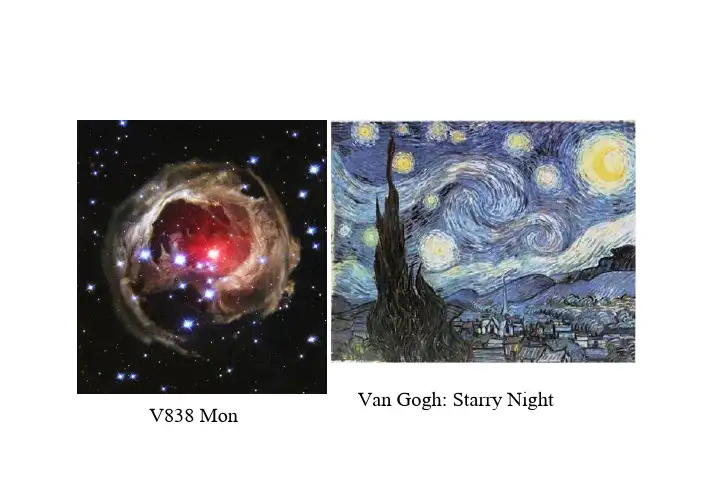
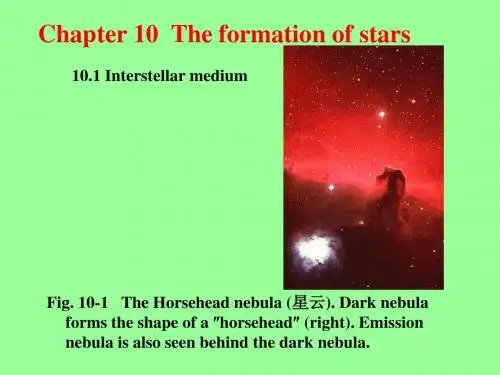
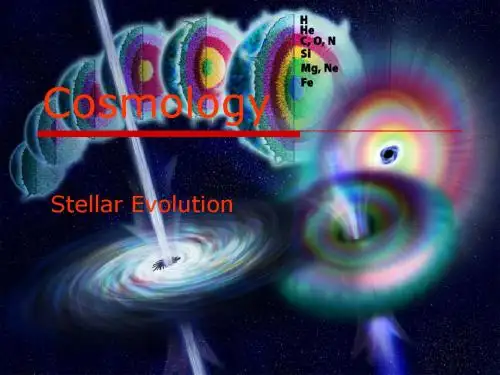
![[论文]恒星的形成与演化](https://uimg.taocdn.com/51795611eef9aef8941ea76e58fafab069dc4434.webp)
恒星的形成与演化一、恒星的形成恒星是茫茫宇宙中除太阳、月亮和少数行星之外最引人注目的天体.早在上古时代,人们就对恒星充满了好奇与幻想,中外都流行着非常动人的神话传说.然而,直到望远镜出现后,人们才对恒星有了最基本的认识,了解到恒星在天空中并不是恒定不变的.到了2 0世纪初,爱因斯坦发表了著名的质能关系,人们对原子核反应所产生的巨大能量逐步认识,知道了恒星能量的来源,才渐渐认识到恒星本身也有生命周期,它们像人一样会出生、生长、老去直至死亡.然而,恒星的出生在相当长的时间里还是个谜,直到2 0世纪6 0年代,天文学家在星际空间发现了分子气体,以及嵌埋其中的低温原恒星( p r o t o s t a r) ,才对恒星的出生场所及过程有了最初步的了解.经过 4 0年的研究,天文学家对恒星的出生过程有了相当充分的理解,特别对小质量恒星而言更是如此.现在已经很清楚,恒星是在以分子气体为主的星际分子云中生成的,由于分子云自身的引力作用,开始自身的塌缩并形成所谓的年轻星天体( y o u n g s t e l l a r o b j e c t s ) ,这些年轻星天体经过快速演化最终形成恒星.为了对恒星进行分类,天文学家将小于太阳质量3倍的恒星称为小质量星,3 —8倍的称为中等质量星,而大于8倍太阳质量的则称为大质量星.这一分类并不仅仅是表象的不同,事实上它代表了不同类型的恒星形成时不同的物理过程.(一)小质量恒星形成的理论与观测一般认为,恒星是通过分子云核( mo l e c u l a r c o r e )的塌缩而形成的.在银河系内,存在一类由分子气体组成的天体,由于它们呈弥散的云雾状形态,因此被称为分子云( mo l e c u l a r c l o u d ),其总质量约占银河系可视物质质量的1%,其温度很低,大约为1 0 K .分子云在星际空间缓慢演化,在某些局部形成密度相对较高的区域,被称为分子云核.随着分子云核的进一步演化,其内部的热运动压力不能再抵御自身的引力,便开始了所谓引力塌缩,最终形成恒星.根据研究,从分子云核演化成一颗恒星经过了以下4个阶段:( 1 )云核阶段:分子云核内气体运动压力、磁压、引力及外部压力处于基本平衡状态,云核缓慢收缩,温度开始缓慢上升,形成热分子云核;( 2 )主塌缩阶段:当分子云核的内部压力不能抵抗自身引力时,就开始了塌缩.由于云核中心密度较高,塌缩区域最初位于中心,并以当地声速向外扩张,这就构成“先内后外”的塌缩( i n s i d e—o u t c o 1 .1 a p s e ).塌缩形成一个致密的核心,巨大的引力能使中心温度迅速升高.由于云核的自转,外部物质不会直接落到核心,而是在核心周围形成一个致密的盘状结构,称为吸积盘( a c c r e t i o n d i s k );( 3 )主吸积阶段:由于角动量及磁通量守恒原理,最终成为恒星组成部分的物质并不能直接落到中心星上,而是落在吸积盘上,吸积盘通过一系列复杂的过程,将多余的角动量向外传递,使中心星的质量得以继续增加,因此,吸积盘在恒星形成活动中起了至关重要的作用.在此期间,为了释放角动量,系统还通过目前尚不可知的机制向两极方向抛射物质,形成质量外流(outflow).恒星的大部分质量都是通过吸积获得的,巨大的引力能使中心星的温度急剧上升,从而点燃了星中心区域的氘.( 4 )残余物质驱散阶段:质量外流在这一阶段继续存在,外流与星风的作用使恒星形成的残余物质远离中心星,星周物质以及盘物质变得稀薄,外流的开口张角渐渐变大.中心星仍然从盘中吸积物质但其速率已经很小,中心星的质量不会再有实质性的增长,更多的是准静态收缩.中心星的核心部分这时可能已经开始了氢燃烧,外部出现了对流层.当这一阶段结束时,我们就可以在宇宙空间看见一颗性质不同的恒星,被称为主序星.以上4个阶段为小质量恒星形成理论所预言而在观测上都得到了证实.在观测上,天文学家利用不同波段的观测发现了4类年轻星天体,其能谱特征基本符合上述4个阶段.他们还发现了围绕小质量年轻星天体的吸积盘,以及伴随恒星形成活动的质量外流.质量外流在电磁波的各个波段都有表现,如射电波段的分子外流及喷流,红外波段的喷流,以及光学波段的赫比格一哈罗天体( H e b i g—H a r o o b j e c t ).光学和红外光谱观测还发现了年轻星天体的质量吸积特征,有几项射电波段的观测声称找到了分子云核的塌缩特征,虽然这些观测还需要进一步的证实.总之,虽然在一些细节上还有待证实,小质量星的形成之迷已经为天文学家所揭示,由此发展的小质量星形成理论被认为是正确的.(二)大质量星形成理论与观测大质量星能否像小质量星那样,通过塌缩和吸积而成?这是一个很自然的想法.但在经典的理论模型计算中,如果使用与小质量星相同的模型参数则当年轻星的质量大于太阳的10倍时,它所释放的光子光压足以抵御自身的引力,使得吸积盘中的物质所受的净力方向向外,从而停止吸积过程,中心星的质量不再继续增加.这意味着恒星的最大质量为1 0倍太阳质量,但这与实际情形是明显不符的,因为已经观测到100倍太阳质量的恒星.当然,在不改变基本假设的情况下也有解决这一困难的方法.例如,理论天体物理学家提出,减小星周物质的不透明度,可以使它们所受到的光压减小,理论上,这种假设可以使恒星的最大质量达到太阳质量的40倍.另外,考虑到外流的存在,如果大量光子从年轻星的两极溢出(因为两极的物质相对稀薄),能有效地释放光压.最新的理论研究表明,如果光子从外流所形成的空腔中逃逸,可以使恒星最大质量达到60倍太阳质量,甚至更大.为解决大质量星的光压使吸积停止这一困难,有人提出了另一种思路,即并合说.这种假说是基于大质量星总是与其他小质量星成团出现的观测事实.并合说主张,在最初阶段,通过分子云核的塌缩,形成一团小质量年轻星天体,这些天体经过一段时间的动力学演化,越来越接近,最后发生碰撞并合并在一起,形成大质量星.这一理论同样存在一些弱点.首先,目前观测到的恒星形成区的年龄一般在10e6至10e7年之间,这意味着,大质量星必须在这段时间内形成,要使小质量星团在如此短的时间里发生碰撞合并,需要非常高的星团密度,计算表明,这一密度必须大于每立方光年10e6. 颗年轻星.然而,目前观测到的最大星团密度约为每立方光年10e3颗,比所需的数值小了3个量级.其次,年轻星发生并合时,能释放巨大的引力能,其光度将会增加几个量级,不亚于一颗超新星的爆发,同时还可能伴随高能的活动现象,如γ射线暴及x射线暴,上述现象在目前为止的观测中未得到证实.至此,理论天体物理学家提供了两种不同的大质量星形成的模式,即吸积说(像小质量星形成一样)与并合说.解决争论的唯一途径是通过观测,但由于目前的观测条件所限,我们不能直接看见发生在大质量星附近的事件,只能通过观测大质量周围的现象推测理论的正确性.回忆小质量星形成的理论,可知吸积学说预言恒星形成时存在双极质量外流以及吸积盘.另一方面,并合说指出,由于年轻星碰撞合并等剧烈的动力学过程,星周盘将在这一过程中被瓦解;并合时可能引发物质的向外喷射,与外流有些相似,但一般不会出现高准直的双极型形态.二、恒星的演化1.引力收缩阶段恒星最初诞生于太空中的星际尘埃,科学家形象地称之为“星云”或者“星际云”,其主要成分由氢组成,密度极小,但体积和质量巨大。
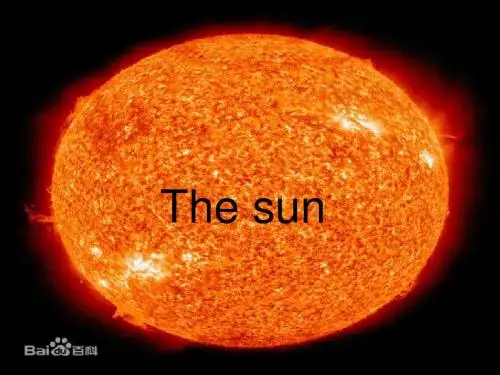
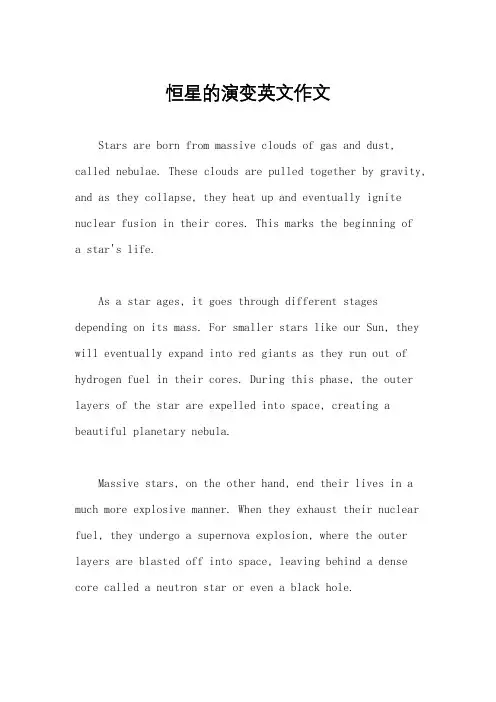
恒星的演变英文作文Stars are born from massive clouds of gas and dust, called nebulae. These clouds are pulled together by gravity, and as they collapse, they heat up and eventually ignite nuclear fusion in their cores. This marks the beginning ofa star's life.As a star ages, it goes through different stages depending on its mass. For smaller stars like our Sun, they will eventually expand into red giants as they run out of hydrogen fuel in their cores. During this phase, the outer layers of the star are expelled into space, creating a beautiful planetary nebula.Massive stars, on the other hand, end their lives in a much more explosive manner. When they exhaust their nuclear fuel, they undergo a supernova explosion, where the outer layers are blasted off into space, leaving behind a dense core called a neutron star or even a black hole.After a star has gone through its final stages, it may leave behind a remnant such as a white dwarf, neutron star, or black hole. These objects continue to cool and fade away over billions of years, eventually becoming dark, cold remnants of what was once a shining star.Throughout their lifetimes, stars play a crucial rolein the universe by creating and dispersing heavy elements that are essential for the formation of planets, and even life itself. Without the life cycle of stars, the universe as we know it would not exist.。

恒星的演化过程是什么恒星的起源和演化,长久以来一直是天文学中最基本、也最令人感兴趣的问题。
小编就和大家分享恒星的演化过程,来欣赏一下吧。
恒星的演化过程(一)恒星的形成恒星形成可分为两个阶段:第一阶段是星云阶段,由极其稀薄的物质凝聚成星云并进一步收缩成原恒星。
第二阶段是原恒星阶段,由原恒星逐渐发展成为恒星。
一般把处于慢收缩阶段的天体称为原恒星。
原恒星进一步形成恒星的收缩过程要持续几百万到几千万年。
(二)恒星的演化恒星的演化如同人的一生,经历从青壮年到更年期、老年期的过程。
(1)恒星的“青壮年期”恒星的“青年期”和“壮年期”是一生中最长的黄金阶段,这时的恒星称为主序星。
人们迄今所知的恒星约有90%都属主序星。
在这段时间,恒星以几乎不变的恒定光度发光发热,照亮周围的宇宙空间。
核燃烧使恒星内部物质产生向外的辐射压力,当辐射压力与引力达到平衡时,恒星的体积和温度就不再明显变化。
(2)恒星的“更年期”恒星的“更年期”出现在恒星核心部分的氢完全转变成氦后,例如有7个太阳质量大小的恒星的“更年期”大约在形成的2600万年后出现。
这一阶段恒星核心经历这些不同的核聚变反应,恒星也经历多次收缩膨胀,其光度也发生周期性的变化。
最后产生巨大辐射压力,自恒星内部往外传递,并将恒星的外层物质迅速推向外围空间,形成红巨星、红超巨星。
(3)恒星的“老年期”恒星的“老年期”是从一颗恒星变成红巨星开始进入这一阶段的。
由于恒星的体积急剧增大,导致恒星的表面温度下降,因而颜色变红。
同时,恒星发光表面的面积剧增,致使整个恒星发出的光大大增强,从而大为增亮。
这种又红又亮的恒星就是红巨星。
(三)恒星的归宿恒星内部的热核反应是不会永远进行下去的,当恒星的核燃料耗尽时恒星也走到了它的尽头。
由于恒星自身物质之间的巨大引力始终存在,随着恒星内部热核反应的停止,尽管恒星外层部分会出现膨胀、爆发等复杂的变动,核心部分却必定在引力作用下发生急剧的收缩、即所谓引力坍缩。

解密太阳系的奥秘:探索宇宙中行星和恒星的新发现1. 引言1.1 概述太阳系作为人类研究和探索的焦点之一,一直充满着令人着迷的奥秘。
随着科技的进步和观测技术的革新,我们对行星和恒星有了更深入的认识和理解。
本文将带领读者一起解密太阳系中行星和恒星的奥秘,并介绍最新的发现和研究成果。
1.2 文章结构本文主要分为五个部分。
首先,在第二部分中,我们将讨论太阳系的形成与演化过程,探索行星形成的奥秘以及冥王星地位变迁等问题。
接下来,在第三部分中,我们将介绍最新外太空行星观测技术进展,以及火星水资源探测结果和木星及其卫星探索的新突破。
然后,在第四部分中,我们将深入了解各种恒星类型和特征,并解析恒星寿命和演化过程。
此外,我们还将关注恒星间相互影响和对恒星团进行研究的进展。
最后,在第五部分中,我们将介绍一些前沿研究方向,包括超新星爆发暴涨模拟预测研究最新成果和黑洞世界边缘实验监测进展。
同时,我们还将思考观测数据背后的宇宙奥秘,并展望未来的挑战。
1.3 目的本文的目的是通过解密太阳系的奥秘,帮助读者了解行星和恒星的形成、演化和特征。
通过介绍最新的科学研究成果,我们希望激发读者对宇宙未知之谜的好奇心,并让他们对前沿研究方向有所了解。
希望读者能在本文中收获全新的知识,对宇宙充满更多的敬畏和探索欲望。
2. 太阳系的形成与演化2.1 形成过程太阳系的形成是一个约46亿年前发生的复杂过程。
最早的证据可以追溯到恒星诞生的星云,大约在宇宙诞生之后的几百万年内。
根据现代天文学家的理论和模型,太阳系的形成经历了以下几个关键步骤:首先,巨大而稳定的分子云被引力作用开始崩塌。
这种云由气体和尘埃组成,并且可能是由超新星爆炸释放出来的物质。
随着云坍缩,材料开始绕着中心点旋转。
这个旋转过程形成了一个扁平的圆盘结构,称为原行星盘或原始太阳盘。
在这个盘中,物质逐渐聚集并且形成更加紧密和密集的区域。
在原行星盘中,尘埃和气体汇聚成更大而更重的类地行星、巨型气态行星以及其他天体。
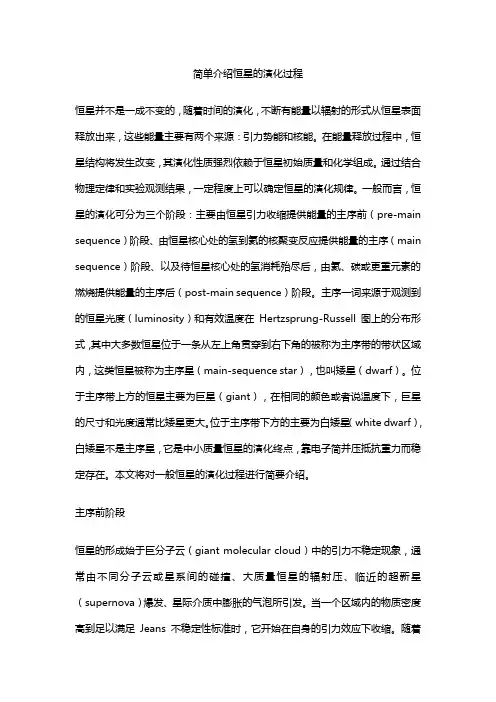
简单介绍恒星的演化过程恒星并不是一成不变的,随着时间的演化,不断有能量以辐射的形式从恒星表面释放出来,这些能量主要有两个来源:引力势能和核能。
在能量释放过程中,恒星结构将发生改变,其演化性质强烈依赖于恒星初始质量和化学组成。
通过结合物理定律和实验观测结果,一定程度上可以确定恒星的演化规律。
一般而言,恒星的演化可分为三个阶段:主要由恒星引力收缩提供能量的主序前(pre-main sequence)阶段、由恒星核心处的氢到氦的核聚变反应提供能量的主序(main sequence)阶段、以及待恒星核心处的氢消耗殆尽后,由氦、碳或更重元素的燃烧提供能量的主序后(post-main sequence)阶段。
主序一词来源于观测到的恒星光度(luminosity)和有效温度在Hertzsprung-Russell 图上的分布形式,其中大多数恒星位于一条从左上角贯穿到右下角的被称为主序带的带状区域内,这类恒星被称为主序星(main-sequence star),也叫矮星(dwarf)。
位于主序带上方的恒星主要为巨星(giant),在相同的颜色或者说温度下,巨星的尺寸和光度通常比矮星更大。
位于主序带下方的主要为白矮星(white dwarf),白矮星不是主序星,它是中小质量恒星的演化终点,靠电子简并压抵抗重力而稳定存在。
本文将对一般恒星的演化过程进行简要介绍。
主序前阶段恒星的形成始于巨分子云(giant molecular cloud)中的引力不稳定现象,通常由不同分子云或星系间的碰撞、大质量恒星的辐射压、临近的超新星(supernova)爆发、星际介质中膨胀的气泡所引发。
当一个区域内的物质密度高到足以满足Jeans 不稳定性标准时,它开始在自身的引力效应下收缩。
随着收缩过程的进行,分子云的引力势能转化为热能,云内气体的密度和温度不断上升。
当原恒星云(protostellar cloud)接近达到流体静力学平衡的稳定条件时,便会在其核心处形成原恒星(protostar)。
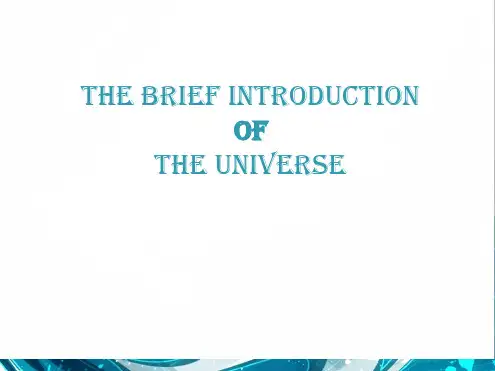
恒星的演化§主序星的演化1、恒星演化的基本原理:恒星在一生的演化中总是试图处于稳定状态(流体静力学平衡和热平衡)。
当恒星无法产生足够多的能量时,它们就无法维持热平衡和流体静力学平衡,于是开始演化。
引力在其中起了关键的作用。
恒星从星云中诞生,这个结果是引力造成的,因为引力使得星云中的物质聚集成了恒星。
但是另一方面,引力会使得它在体积上不断收缩,为了使得引力作用在某种程度上达到平衡,恒星需要在内部产生能量,产生能量的目的是为了抗衡引力,否则它会持续收缩。
在达到平衡的过程里,恒星要付出代价,恒星要不断消耗自身物质,产生新的元素,元素在转化的过程中能量释放出来,内部结构也会发生变化,最终有一天恒星没有任何能源可以供给,它的生命就结束了。
所以说恒星的一生是一部与引力斗争的历史。
2、Russel-Vogt原理如果恒星处于流体静力学平衡和热平衡,而且它的能量来自内部的核反应,它们的结构和演化就会完全唯一地由初始质量和化学丰度决定。
这个原理在实际上可能不是非常符合,因为恒星的质量会不可避免地发生变化,但是初始质量和化学丰度仍然是决定恒星结构和演化的重要因素。
这里我们主要谈质量的影响。
3、恒星演化时标核时标(Nuclear Timescale):恒星内部通过核心区(约占恒星质量的十分之一)核反应的产能时间。
比如太阳,它并不是把所有的质量都烧光了,它其实只有0.1倍太阳质量作为可用的燃料。
我们有下面的结果:t n=EL=ηΔMc2L≈0.7%0.1Mc2L≈(1010yr)(MM⊙)LL⊙E是它总的能量,L是光度,也就是它能量消耗的速率,E可以写成ΔMc2,,其中ΔM是恒星核心区的质量,并不是恒星的总质量,η是能量转换的效率。
上式是以太阳质量和太阳光度作为单位的。
一旦恒星的核燃料烧光了,它会快速地变化,进入新的平衡状态,新的平衡状态转变的时标比核反应时标要快得多。
热时标(Thermal Timescale):恒星辐射自身热能的时间,或光子从恒星内部到达表面的时间,是指恒星把自身能量或热量全部辐射光了。
探索宇宙奥秘:恒星的形成与演化1. 引言1.1 概述恒星是宇宙中最基本的天体,它们以其巨大的质量和炽热的光芒在银河系中闪耀。
恒星的形成和演化是天文学领域最激动人心的课题之一。
通过对恒星形成和演化过程的深入研究,我们可以更好地理解宇宙的起源和发展。
1.2 文章结构本文将探讨恒星的形成与演化过程,并分析恒星对宇宙的重要性。
首先,我们将介绍分子云的形成与演化,这是恒星形成的基础。
接着,我们将详细描述原恒星的形成过程以及恒星主序演化阶段。
然后,我们将探讨红巨星阶段、超新星爆发以及黑洞和中子星等残骸形成过程。
最后,我们将阐述恒星对宇宙生命起源、能量来源以及对行星系统和生物多样性的影响。
1.3 目的本文旨在提供关于恒星形成和演化方面最新研究进展的全面概览,并强调恒星在宇宙中的重要性。
通过阐明恒星对光、能量和化学元素合成方面的贡献,我们将更好地认识到宇宙中恒星与行星系统以及生命之间的千丝万缕的联系。
同时,本文还将展望未来在恒星形成和演化领域可能的研究方向,为进一步探索宇宙奥秘提供理论基础。
以上是文章“1. 引言”部分内容的详细清晰描述。
2. 恒星的形成2.1 分子云的形成与演化:恒星形成的第一步是由分子云开始。
分子云是巨大的气体和尘埃结构,由氢、氦以及其他重元素组成。
这些分子云通常在银河系中的星际空间中存在。
当这些分子云中的某个区域受到压缩或干扰时,它就会开始坍缩并形成恒星。
整个过程可以追溯到数百万年前,其中引力起着重要作用。
当分子云内部的气体积聚在一点时,引力会增加,导致更多的气体聚集在该点周围。
这种压缩将继续,直到最终形成一个密度非常高且温度很高的区域,我们称之为原恒星诞生地。
2.2 原恒星的形成过程:原恒星是指在恒星形成阶段之后但尚未进入主序演化阶段的恒星。
一旦原恒星诞生地达到足够高的密度和温度,核融合反应将在其中心开始发生。
这些反应使得氢被转化为更重的元素,并释放出大量的能量。
原恒星的形成过程可以分为以下几个阶段:原恒星诞生,原恒星第一次核融合,以及原恒星的演化。
恒星演化的主要过程和结果
恒星演化是指恒星从形成到灭亡的整个过程。
以下是恒星演化的主要过程和结果:
1. 恒星形成:恒星形成于巨大的分子云中,当分子云内部达到足够高的密度和温度时,引力会使得物质坍缩形成原恒星。
2. 主序阶段:一颗恒星进入主序阶段后,核反应将氢转化为氦,释放出能量使恒星保持稳定与平衡。
3. 红巨星阶段:主序阶段结束后,恒星的核心会耗尽氢燃料,核反应减弱,外层气体膨胀形成红巨星。
大部分低质量恒星(比如太阳)将经历这一阶段。
4. 行星状星云阶段:在红巨星阶段结束后,恒星的外层气体会被甩出形成一个亮度较高的行星状星云,恒星内部的核心则变成白矮星。
5. 猎户座餘星:当恒星质量较高时(大约8至20倍太阳质量),在核心氢燃料耗尽后,核心会塌缩并引发更强烈的核反应,形成高温和高能量的恒星,这就是餘星。
6. 超新星爆发:当恒星质量超过20倍太阳质量,核心耗尽核燃料后将发生剧烈的超新星爆发。
爆发过程中,恒星会释放出极大的能量和物质,有些物质形成中子星或黑洞。
7. 白矮星:低质量恒星在红巨星阶段结束后,核心会成为非常密集的物质,形成白矮星。
白矮星的核心由电子形成,没有核反应维持,它们会逐渐冷却变暗。
8. 中子星或黑洞:在超新星爆发后,留下的残骸可能会形成中子星或黑洞。
中子星是极为致密的恒星遗骸,几乎完全由中子组成。
黑洞是更极端和更致密的恒星遗骸,具有极强的引力场。
这些过程和结果可能会因恒星质量、旋转速度以及初始成分等因素的不同而有所差异。
整个恒星演化过程是宇宙中星系和行星系的重要组成部分,也对太阳系的形成和生命的起源产生了深远影响。
恒星的演化英语作文Title: The Evolution of Stars。
Stars, those luminous celestial bodies scattered across the vast expanse of the universe, undergo a fascinating journey of evolution throughout their lifespan. From their birth in dense clouds of gas and dust to their eventual demise, stars exhibit a variety of stages and transformations that shape the cosmos as we know it.Formation:Stars are born within immense clouds of molecular gas and dust called nebulae. These clouds are composedprimarily of hydrogen and helium, along with traces of other elements. Gravitational forces cause regions within the nebulae to collapse, leading to the formation of protostars. As the protostar continues to accrete matter from its surrounding disk, it grows hotter and denser, eventually reaching a point where nuclear fusion ignites inits core.Main Sequence:Once nuclear fusion begins, a star enters the main sequence phase, where it achieves equilibrium between the inward pull of gravity and the outward pressure generated by nuclear fusion reactions in its core. During this phase, stars like our Sun fuse hydrogen atoms into helium in their cores, releasing a tremendous amount of energy in the process. The duration of the main sequence phase varies depending on the mass of the star, with more massive stars burning through their fuel more quickly than lower-mass stars.Red Giant/Supergiant:As a star exhausts its hydrogen fuel in the core, it undergoes significant changes in its structure. For stars like the Sun, the core contracts while the outer layers expand, transforming the star into a red giant. In this phase, the star's outer layers cool and redden, even as itscore continues to undergo nuclear fusion reactions involving helium. For more massive stars, the evolution leads to the formation of a supergiant, characterized by even greater expansion and luminosity.Planetary Nebula/Supernova:Eventually, stars exhaust their nuclear fuel entirely, leading to their final stages of evolution. Low to intermediate mass stars, like the Sun, shed their outer layers in a process called a planetary nebula. The remaining core, known as a white dwarf, gradually cools over billions of years, eventually fading into a dark remnant known as a black dwarf.In contrast, massive stars undergo a more dramatic end known as a supernova. When these stars deplete their nuclear fuel, they can no longer sustain the outward pressure needed to counteract gravity. The core collapses rapidly, triggering a catastrophic explosion that blasts away the outer layers of the star into space. What remains can either be a neutron star or, in the case of extremelymassive stars, a black hole.Conclusion:The evolution of stars is a testament to the intricate interplay between gravity and the fundamental forces governing the universe. From their humble beginnings as swirling clouds of gas and dust to their explosive finales, stars shape the cosmos around them and provide theessential elements necessary for the formation of planets, life, and ultimately, the complexity of the universe itself. As we continue to study and explore these celestial phenomena, we gain a deeper understanding of our place inthe cosmos and the remarkable processes that govern the universe.。
恒星的演化恒星是一个不断向宇宙空间辐射巨大能量的自引力炽热气体球。
恒星的主要能量来源是在其核心处发生的热核反应,当星体收缩或坍缩时也会释放一定的能量。
恒星为了维持足够的内部压力来支持自身的巨大引力必须产生能量。
恒星的结构和演化受两种相反的作用所支配:力图使恒星坍缩的引力和企图使恒星膨胀的内部压力。
当引力占优时恒星表现为坍缩,压力占优时则表现为膨胀。
由于恒星在不断辐射能量,最终引力将使恒星坍缩为冷的致密星,如白矮星、中子星甚至黑洞。
引力在恒星演化过程中将起决定性的作用。
1. 恒星演化进程概述恒星的演化是天体物理中最基本的问题之一。
恒星是怎样诞生、生长、衰老和死亡的,这是一个十分复杂的问题,也是非常困难的问题。
目前对恒星演化的进程已经有了相当多的认识,有一张比较清晰的图象。
随着观测和研究的不断深入,恒星演化进程的图象会越来越清晰。
一般认为恒星起源于星际物质。
在引力扰动作用下,星际物质收缩成密度较大的弥漫星云,最后进一步收缩成原始恒星。
原恒星在引力作用下进一步收缩,形成一个密度极大的核心,温度越来越高,最终达到氢的点火温度—氢聚变为氦的热核反应开始了,恒星进入了主序星阶段。
恒星将在主序渡过一生最长的阶段。
当恒星内部10%-20%的氢耗尽后,恒星就离开主序,向红巨星发展。
氢的聚变反应停止后,恒星在引力收缩下,核心将达到氦点火的温度,开始氦的聚变反应。
以后逐步进入碳、氧、硅等燃烧阶段,最后形成洋葱状的结构,中心是最稳定的铁核。
恒星最后的演化过程基本上取决于恒星的质量,当然与其他因素也会有一定关系。
恒星演化的最后阶段可能形成三种产物,即白矮星、中子星或黑洞。
白矮星很早就在天文观测中被发现了,理论上的分析由Chanderasekhar 在1931年完成。
并因此而获得1983年的Nobel物理奖。
中子星的可能则早在20世纪30年代就被物理学家提出来了,但因为中子星的直径只有10公里左右,很难观测到。
一直到1967年才由Hewish及其研究生Bell发现。
The evolution of starsStars are the most noticeable objects in the vast universe except the sun, moon and a few planets. In ancient times, people were full of curiosity and fantasy about stars, and very moving myths and legends were popular in China and abroad. However, it was not until the telescope appeared that people had the most basic understanding of stars and realized that stars were not constant in the sky.At the beginning of the20th century, Einstein published the famous mass-energy relationship, people gradually realized the huge energy produced by the nuclear reaction and knew the source of the star's energy before they gradually realized that the star itself also had a life cycle, they would be born, grow, and die just like people. However, the birth of stars was still a mystery for a long time. It was not until the 1960s that astronomers discovered molecular gas in interstellar space that they had the most preliminary understanding of the evolution process of stars. Next, I’d like to share it. Gravitational contraction stageThe star was originally born from interstellar dust in space. Scientists call it "nebula" or " interstellar cloud" vividly. Its main component is hydrogen, which is extremely small indensity but huge in volume and mass. The nebula with enough density continuously shrinks and its temperature rises under the action of its own gravity.When the temperature reaches 10 million degrees, a thermonuclear fusion reaction takes place inside it, releasing a large amount of atomic energy and forming radiation pressure, when the pressure increases enough to compete with the gravitational pull of its contraction, a star is born.Main sequence starThe stage in which a star uses internal hydrogen and helium fusion as its main energy source is the main sequence stage of the star, which is the ‘youth” of the star. It is the longest golden stage in the life of the star and occupies 90 % of its entire life span.During this period of time, the star is relatively stable, the two forces of outward expansion and inward contraction are roughly balanced. The star does not shrink or expand basically, and emits heat with almost constant luminosity, illuminating the surrounding space.The time that different stars stay in the main sequence stage varies greatly with different masses.The greater the mass, the greater the luminosity, the faster the energy consumption, and the shorter the time spent in the mainsequence stage.Stars whose mass is equal to 15, 5, 1, and 0.2 times the mass of the sun are in the main sequence stage for 10 million years, 70 million years, 10 billion years, and 1 trillion years respectively.Red giant star stageWhen a star passes through its long main sequence stage, it will first become a red giant star.Because the burning consumption of hydrogen in thermonuclear reactions increases, the rate of helium formation will continue to increase.Soon, the hydrogen around the helium core will become very small, and the energy generated by the central core will no longer be sufficient to maintain its radiation pressure, so the balance will be broken and the gravitational force will be greater than the radiation pressure. After that, the process of star evolution is that the inner core shrinks and the outer shell expands. At the same time, the outer shell of the star expands outward and keeps getting cold, and the surface temperature is greatly reduced. The process only lasts hundreds of thousands of years, and the star becomes a red giant in rapid expansion.Because the volume will expand to 1 billion times and is very huge, it is called "superstar".While the star isexpanding rapidly, its outer surface is getting farther and farther away from the center, its mass is easy to lose and its temperature is getting lower and lower, and the emitted light is getting redder and redder, so it is called a "red" giant star. Because of its huge volume, its luminosity has also become very large, extremely bright. Many of the brightest stars visible to the naked eye are red giant stars.Outbreak stageThe stars in their later years are very unstable. One day they will explode violently. By then, the whole star will have formed its own life with an extremely spectacular explosion, throwing most of its material into the sky, turning it into a nebula again, and releasing huge energy at the same time. In this way, in just a few days, its luminosity is likely to increase by several hundred thousand times. This kind of star is called "nova". If the stellar explosion is more violent, its luminosity can even increase by more than 1,000,000 times or even 10,000 times. This kind of star is called "supernova." The explosion of new stars or supernovae is an important link in the evolution of celestial bodies. It is the brilliant funeral of old stars and also the promoter of the birth of new stars. Theexplosion of supernovae may lead to the birth of countless stars in nearby nebulae.High density stageAfter the explosion, the supernova left only ahigh-density debris, instead of a star.Stars with a mass below 1 - 3 times the mass of the sun lose enough mass without drastic changes after leaving the main star sequence belt, and end their lives relatively peacefully and become a white dwarf.Stars with 3 times the mass of the sun will end up in supernova explosions. Within seconds of the explosion, the core will begin to collapse and eventually collapse into dense neutron stars.The mass of neutron stars is not infinite.If the core residual mass still exceeds about three times the mass of the sun after the supernova explosion, the central portion will continue to shrink.Finally, when the mass shrinks to a very small extent, the gravitational force near it is large enough to make the fastest moving light unable to get rid of its confinement.This celestial body cannot send any information to the outside world, which is called a black hole.In this way, stars come to the nebula and return to the nebula, completing its glorious life.。